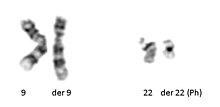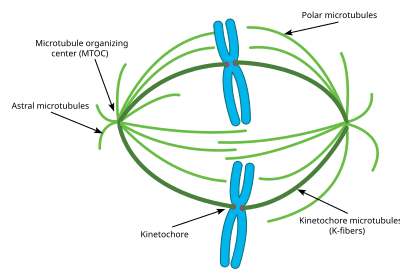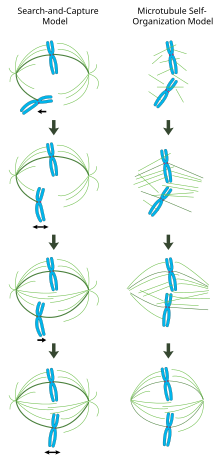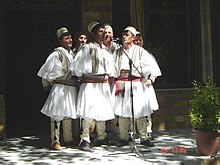A metaphase cell positive for the BCR/ABL rearrangement using FISH
Cytogenetics is essentially a branch of genetics, but is also a part of cell biology/cytology (a subdivision of human anatomy), that is concerned with how the chromosomes relate to cell behaviour, particularly to their behaviour during mitosis and meiosis. Techniques used include karyotyping, analysis of G-banded chromosomes, other cytogenetic banding techniques, as well as molecular cytogenetics such as fluorescent in situ hybridization (FISH) and comparative genomic hybridization (CGH).
History
During early time
Chromosomes were first observed in plant cells by Karl Wilhelm von Nägeli in 1842. Their behavior in animal (salamander) cells was described by Walther Flemming, the discoverer of mitosis, in 1882. The name was coined by another German anatomist, von Waldeyer in 1888.
The next stage took place after the development of genetics in
the early 20th century, when it was appreciated that the set of
chromosomes (the karyotype) was the carrier of the genes. Levitsky seems to have been the first to define the karyotype as the phenotypic appearance of the somatic chromosomes, in contrast to their genic contents. Investigation into the human karyotype took many years to settle the most basic question: how many chromosomes does a normal diploid human cell contain? In 1912, Hans von Winiwarter reported 47 chromosomes in spermatogonia and 48 in oogonia, concluding an XX/XO sex determination mechanism. Painter in 1922 was not certain whether the diploid number of humans was 46 or 48, at first favoring 46. He revised his opinion later from 46 to 48, and he correctly insisted on humans having an XX/XY system of sex-determination.
Considering their techniques, these results were quite remarkable. In
science books, the number of human chromosomes remained at 48 for over
thirty years. New techniques were needed to correct this error. Joe Hin Tjio working in Albert Levan's lab was responsible for finding the approach:
- Pre-treating cells in a hypotonic solution, which swells them and spreads the chromosomes
- Arresting mitosis in metaphase by a solution of colchicine
- Squashing the preparation on the slide forcing the chromosomes into a single plane
- Cutting up a photomicrograph and arranging the result into an indisputable karyogram.
It took until 1956 for it to be generally accepted that the karyotype of man included only 46 chromosomes. The great apes have 48 chromosomes. Human chromosome 2 was formed by a merger of ancestral chromosomes, reducing the number.
Applications in biology
McClintock's work on maize
Barbara McClintock began her career as a maize cytogeneticist. In 1931, McClintock and Harriet Creighton demonstrated that cytological recombination of marked chromosomes correlated with recombination of genetic traits (genes). McClintock, while at the Carnegie Institution,
continued previous studies on the mechanisms of chromosome breakage and
fusion flare in maize. She identified a particular chromosome breakage
event that always occurred at the same locus on maize chromosome 9,
which she named the "Ds" or "dissociation" locus.
McClintock continued her career in cytogenetics studying the mechanics
and inheritance of broken and ring (circular) chromosomes of maize.
During her cytogenetic work, McClintock discovered transposons, a find which eventually led to her Nobel Prize in 1983.
Natural populations of Drosophila
In the 1930s, Dobzhansky and his coworkers collected Drosophila pseudoobscura and D. persimilis from wild populations in California and neighboring states. Using Painter's technique they studied the polytene chromosomes and discovered that the wild populations were polymorphic for chromosomal inversions. All the flies look alike whatever inversions they carry: this is an example of a cryptic polymorphism.
Evidence rapidly accumulated to show that natural selection was responsible. Using a method invented by L'Héritier and Teissier, Dobzhansky bred populations in population cages, which enabled feeding, breeding and sampling whilst preventing escape. This had the benefit of eliminating migration
as a possible explanation of the results. Stocks containing inversions
at a known initial frequency can be maintained in controlled conditions.
It was found that the various chromosome types do not fluctuate at
random, as they would if selectively neutral, but adjust to certain
frequencies at which they become stabilised. By the time Dobzhansky
published the third edition of his book in 1951
he was persuaded that the chromosome morphs were being maintained in
the population by the selective advantage of the heterozygotes, as with
most polymorphisms.
Lily and mouse
The
lily is a favored organism for the cytological examination of meiosis
since the chromosomes are large and each morphological stage of meiosis
can be easily identified microscopically. Hotta et al.
presented evidence for a common pattern of DNA nicking and repair
synthesis in male meiotic cells of lilies and rodents during the
zygotene–pachytene stages of meiosis when crossing over was presumed to
occur. The presence of a common pattern between organisms as
phylogenetically distant as lily and mouse led the authors to conclude
that the organization for meiotic crossing-over in at least higher
eukaryotes is probably universal in distribution.
Human abnormalities and medical applications
Philadelphia translocation t(9;22)(q34;q11.2) seen in chronic myelogenous leukemia.
Following the advent of procedures which allowed easy enumeration of
chromosomes, discoveries were quickly made related to aberrant
chromosomes or chromosome number. In some congenital disorders, such as Down syndrome, cytogenetics revealed the nature of the chromosomal defect: a "simple" trisomy. Abnormalities arising from nondisjunction events can cause cells with aneuploidy (additions or deletions of entire chromosomes) in one of the parents or in the fetus. In 1959, Lejeune discovered patients with Down syndrome had an extra copy of chromosome 21. Down syndrome is also referred to as trisomy 21.
Other numerical abnormalities discovered include sex chromosome abnormalities. A female with only one X chromosome has Turner syndrome, whereas an additional X chromosome in a male, resulting in 47 total chromosomes, has Klinefelter syndrome.
Many other sex chromosome combinations are compatible with live birth
including XXX, XYY, and XXXX. The ability for mammals to tolerate
aneuploidies in the sex chromosomes arises from the ability to inactivate them,
which is required in normal females to compensate for having two copies
of the chromosome. Not all genes on the X chromosome are inactivated,
which is why there is a phenotypic effect seen in individuals with extra
X chromosomes.
Trisomy 13 was associated with Patau syndrome and trisomy 18 with Edwards syndrome.
In 1960, Peter Nowell and David Hungerford discovered a small chromosome in the white blood cells of patients with Chronic myelogenous leukemia (CML). This abnormal chromosome was dubbed the Philadelphia chromosome - as both scientists were doing their research in Philadelphia, Pennsylvania. Thirteen years later, with the development of more advanced techniques, the abnormal chromosome was shown by Janet Rowley to be the result of a translocation of chromosomes 9 and 22. Identification of the Philadelphia chromosome by cytogenetics is diagnostic for CML.
Advent of banding techniques
Human male karyotype.
In the late 1960s, Torbjörn Caspersson
developed a quinacrine fluorescent staining technique (Q-banding) which
revealed unique banding patterns for each chromosome pair. This allowed
chromosome pairs of otherwise equal size to be differentiated by
distinct horizontal banding patterns. Banding patterns are now used to
elucidate the breakpoints and constituent chromosomes involved in chromosome translocations.
Deletions and inversions within an individual chromosome can also be
identified and described more precisely using standardized banding
nomenclature. G-banding (utilizing trypsin and Giemsa/ Wright stain) was
concurrently developed in the early 1970s and allows visualization of
banding patterns using a bright field microscope.
Diagrams identifying the chromosomes based on the banding patterns are known as idiograms.
These maps became the basis for both prenatal and oncological fields to
quickly move cytogenetics into the clinical lab where karyotyping
allowed scientists to look for chromosomal alterations. Techniques were
expanded to allow for culture of free amniocytes recovered from amniotic fluid, and elongation techniques for all culture types that allow for higher-resolution banding.
Beginnings of molecular cytogenetics
In the 1980s, advances were made in molecular cytogenetics. While radioisotope-labeled probes had been hybridized with DNA
since 1969, movement was now made in using fluorescent labeled probes.
Hybridizing them to chromosomal preparations using existing techniques
came to be known as fluorescence in situ hybridization (FISH).
This change significantly increased the usage of probing techniques as
fluorescent labeled probes are safer. Further advances in
micromanipulation and examination of chromosomes led to the technique of
chromosome microdissection whereby aberrations in chromosomal structure could be isolated, cloned and studied in ever greater detail.
Techniques
Karyotyping
The routine chromosome analysis (Karyotyping) refers to analysis of metaphase chromosomes which have been banded using trypsin followed by Giemsa,
Leishmanns, or a mixture of the two. This creates unique banding
patterns on the chromosomes. The molecular mechanism and reason for
these patterns is unknown, although it likely related to replication timing and chromatin packing.
Several chromosome-banding techniques are used in cytogenetics laboratories. Quinacrine
banding (Q-banding) was the first staining method used to produce
specific banding patterns. This method requires a fluorescence
microscope and is no longer as widely used as Giemsa
banding (G-banding). Reverse banding, or R-banding, requires heat
treatment and reverses the usual black-and-white pattern that is seen in
G-bands and Q-bands. This method is particularly helpful for staining
the distal ends of chromosomes. Other staining techniques include
C-banding and nucleolar
organizing region stains (NOR stains). These latter methods
specifically stain certain portions of the chromosome. C-banding stains
the constitutive heterochromatin, which usually lies near the centromere, and NOR staining highlights the satellites and stalks of acrocentric chromosomes.
High-resolution banding involves the staining of chromosomes during prophase or early metaphase (prometaphase), before they reach maximal condensation. Because prophase and prometaphase
chromosomes are more extended than metaphase chromosomes, the number of
bands observable for all chromosomes increases from about 300 to 450 to
as many as 800. This allows the detection of less obvious abnormalities
usually not seen with conventional banding.
Slide preparation
Cells from bone marrow, blood, amniotic fluid, cord blood, tumor, and tissues (including skin, umbilical cord,
chorionic villi, liver, and many other organs) can be cultured using
standard cell culture techniques in order to increase their number. A mitotic inhibitor (colchicine, colcemid) is then added to the culture. This stops cell division at mitosis
which allows an increased yield of mitotic cells for analysis. The
cells are then centrifuged and media and mitotic inhibitor are removed,
and replaced with a hypotonic solution. This causes the white blood
cells or fibroblasts to swell so that the chromosomes will spread when
added to a slide as well as lyses the red blood cells. After the cells
have been allowed to sit in hypotonic solution, Carnoy's fixative (3:1 methanol to glacial acetic acid)
is added. This kills the cells and hardens the nuclei of the remaining
white blood cells. The cells are generally fixed repeatedly to remove
any debris or remaining red blood cells. The cell suspension is then
dropped onto specimen slides. After aging the slides in an oven or
waiting a few days they are ready for banding and analysis.
Analysis
Analysis of banded chromosomes is done at a microscope
by a clinical laboratory specialist in cytogenetics (CLSp(CG)).
Generally 20 cells are analyzed which is enough to rule out mosaicism to
an acceptable level. The results are summarized and given to a
board-certified cytogeneticist for review, and to write an
interpretation taking into account the patient's previous history and
other clinical findings. The results are then given out reported in an International System for Human Cytogenetic Nomenclature 2009 (ISCN2009).
Fluorescent in situ hybridization
Interphase cells positive for a t(9;22) rearrangement
Fluorescent in situ hybridization (FISH) refers to using fluorescently labeled probe to hybridize to cytogenetic cell preparations.
In addition to standard preparations FISH can also be performed on:
- bone marrow smears
- blood smears
- paraffin embedded tissue preparations
- enzymatically dissociated tissue samples
- uncultured bone marrow
- uncultured amniocytes
- Cytospin preparations
Slide preparation
This section refers to preparation of standard cytogenetic preparations
The slide is aged using a salt solution usually consisting of 2X SSC (salt, sodium citrate). The slides are then dehydrated in ethanol, and the probe mixture is added. The sample DNA
and the probe DNA are then co-denatured using a heated plate and
allowed to re-anneal for at least 4 hours. The slides are then washed to
remove excess unbound probe, and counterstained with
4',6-Diamidino-2-phenylindole (DAPI) or propidium iodide.
Analysis
Analysis of FISH specimens is done by fluorescence microscopy by a clinical laboratory specialist in cytogenetics. For oncology generally a large number of interphase
cells are scored in order to rule out low-level residual disease,
generally between 200 and 1,000 cells are counted and scored. For
congenital problems usually 20 metaphase cells are scored.
Future of cytogenetics
Advances now focus on molecular cytogenetics including automated systems for counting the results of standard FISH preparations and techniques for virtual karyotyping, such as comparative genomic hybridization arrays, CGH and Single nucleotide polymorphism arrays.












